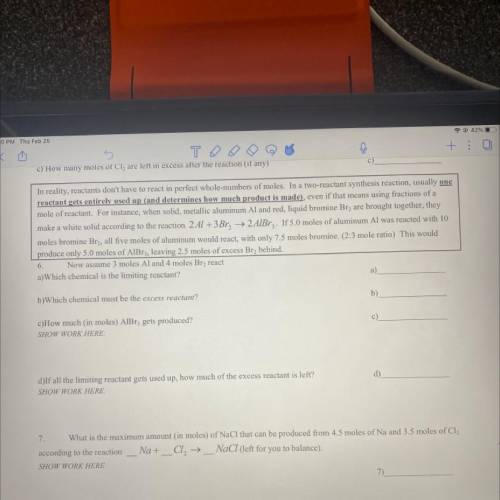
Chemistry, 26.02.2021 02:10 ruffnekswife
In reality, reactants don't have to react in perfect whole-numbers of moles. In a two-reactant synthesis reaction, usually one
reactant gets entirely used up (and determines how much product is made), even if that means using fractions of a
mole of reactant. For instance, when solid, metallic aluminum Al and red, liquid bromine Bry are brought together, they
make a white solid according to the reaction 2. Al + 3 Br, → 2 AIBr, If 5.0 moles of aluminum Al was reacted with 10
moles bromine Bry, all five moles of aluminum would react, with only 7.5 moles bromine. (2:3 mole ratio) This would
produce only 5.0 moles of AIBr;, leaving 2.5 moles of excess Br, behind.
6. Now assume 3 moles Al and 4 moles Br2 react
a)Which chemical is the limiting reactant?
b)Which chemical must be the excess reactant?
b)
c)
c)How much (in moles) AIBr; gets produced?
SHOW WORK HERE:
d)
d)If all the limiting reactant gets used up, how much of the excess reactant is left?
SHOW WORK HERE:
<
7. What is the maximum amount (in moles) of NaCl that can be produced from 4.5 moles of Na and 3.5 moles of Cl2
according to the reaction Na +_ Cl, → _NaCl (left for you to balance).
SHOW WORK HERE:
7).
3
3


Answers: 1


Another question on Chemistry

Chemistry, 21.06.2019 16:30
What is a scientific theory? a. a scientist's guess about how something works b. the results of an experiment obtained using the scientific method c. a proven fact that will never change d. an idea that is backed by data from many sources
Answers: 2

Chemistry, 22.06.2019 13:30
Why does asexual reproduction result in offspring with identicle genetic variation
Answers: 2

Chemistry, 22.06.2019 16:00
If 15 drops of ethanol from a medical dropper weight 0.60g, how many drops does it takes from a dropper to dispense 1.0ml of ethanol? the density of ethanol is 0.80g/ml
Answers: 1

Chemistry, 22.06.2019 17:10
)benzene and toluene form nearly ideal solutions. consider an equimolar solution of benzene and toluene. at 20 °c the vapour pressures of pure benzene and toluene are 9.9 kpa and 2.9 kpa, respectively. the solution is boiled by reducing the external pressure below the vapour pressure. calculate (i) the pressure when boiling begins, (ii) the composition of each component in the vapour, and (iii) the vapour pressure when only a few drops of liquid remain. assume that the rate of vaporization is low enough for the temperature to remain constant at 20 °c.
Answers: 1
You know the right answer?
In reality, reactants don't have to react in perfect whole-numbers of moles. In a two-reactant synth...
Questions


Mathematics, 02.08.2019 15:30





History, 02.08.2019 15:30

Mathematics, 02.08.2019 15:30

History, 02.08.2019 15:30

Mathematics, 02.08.2019 15:30

Social Studies, 02.08.2019 15:30



Mathematics, 02.08.2019 15:30



Mathematics, 02.08.2019 15:30





